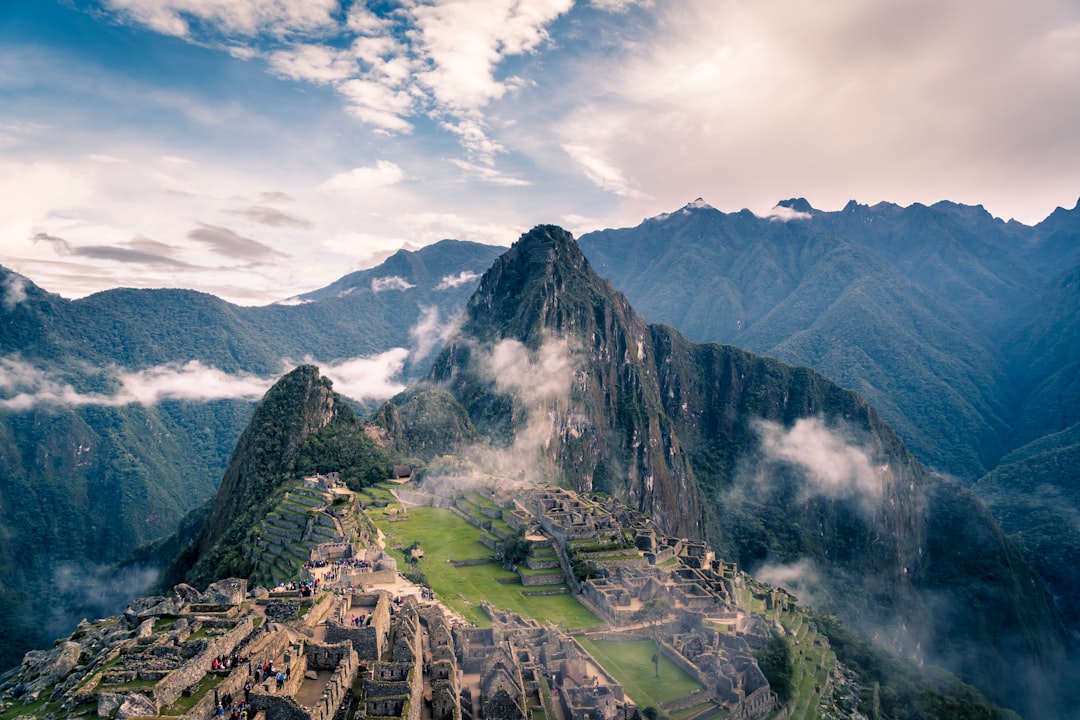Port Guide | Peru | Dive Deep
Machu Picchu

Michael States | Editor
Published on 2025-08-27
Congratulations, intrepid seafarers-you've officially become those people who casually roll into Machu Picchu by cruise ship, an arrival method the ancient Incas would almost certainly find bewildering and probably a bit irritating (though, let's face it, impressively luxurious). As your floating home docks near one of humanity's most improbably placed cities-a citadel built by hand, stone-by-stone, atop a sky-scraping Andean ridge-you're about to discover how effortlessly history, altitude, and llamas conspire to humble even the most world-weary travelers. Practical note: the site's popularity is surpassed only by its thin oxygen levels, so book your entrance tickets pronto, hydrate generously, and prepare for some altitude-induced existential pondering. Once acclimated, may we suggest celebrating your survival by sampling Peru's glorious gift to humanity, the pisco sour, or bravely exploring Cusco's cobblestone streets, where you'll find layers of history nestled between hip cafes, vibrant markets, and alpaca-sweater hawkers who will charm your soles (and wallets) off.

Peru has 9 Travel Advisories
Stay up to day with regional travel advisories.
Notes from the Editor
Machu Picchu is one of the most popular tourist destinations in the world, so travelers are advised to book tickets in advance. Also, altitude sickness may be a concern due to its high elevation.
Where do cruise ships dock in Machu Picchu?
Port Name Machu Picchu
Country Peru
Region South America
Ship Terminal Aguas Calientes Station
Port Type Tender port
Accessibility Machu Picchu is accessible via a train ride from Cusco, followed by a bus ride to the archaeological site. The distance from the train station to Machu Picchu is about 5 km, and typically takes around 20 minutes by bus.
What's the weather like in Machu Picchu?
Best Season to Visit May to September
Climate Machu Picchu generally has a mild and temperate climate, with a dry season and a rainy season.
Weather Notes May to September is the dry season, making it the best time to visit; however, travelers should prepare for possible cold nights.
Temperature Range 50-75 F (10-24 C)
High Temp 75F
Low Temp 50F
Average Temp 63F
What do I need to know about Machu Picchu?
Language Spanish
Currency Peruvian Sol (PEN)
Card Widely Accepted 1
Population About 1,200 (Aguas Calientes)
Timezone Peru Time (PET) UTC-5
How do I get around Machu Picchu?
Train service from Cusco to Aguas Calientes; bus service from Aguas Calientes to Machu Picchu.
What are The Best Things to do in Machu Picchu?
Discover what you should do while you're in Machu Picchu.
Historical and cultural landmarks
Intihuatana Stone | Editor Highlight

Michael States | Editor
Published on 2025-08-27
Best Time to Go
Morning
Cost
$50-$150 USD
Activity Level
Moderate
Where to Book
Online
When you find yourself panting and lightly delirious atop the mist-shrouded terraces of Machu Picchu, amidst selfie-stick jousters and folks in zip-off cargo pants earnestly channeling ancient energies, do yourself a favor: elbow your way politely but firmly toward the marvelously enigmatic Intihuatana Stone. Carved by the Inca around the mid-15th century-likely as a solar calendar or maybe just an elaborate insult to future archaeologists-this ancient sundial defiantly mocks the centuries from its lofty perch. Go early in the morning, preferably at sunrise, before the crush of tour buses unloads throngs of bucket-listers who've been dreaming of Instagram fame since Lima airport. Book your site tickets at least three months in advance (the Peruvians are charming, but spontaneous entry at Machu Picchu is about as likely as a polite llama offering you a guided tour). Budget around $70 for entrance fees, and pack sunscreen, bottled water, and a hearty appreciation for altitude-induced whimsy. Gaze upon the Intihuatana, imagine Incan priests earnestly tracking celestial movements, or perhaps chuckling at future tourists gawping cluelessly. Trust me, standing next to an ancient stone pillar that's survived conquistadors, earthquakes, and aggressively enthusiastic backpackers-just to proudly cast its shadow-is well worth the inevitable altitude headache, if only for the bragging rights at your next dinner party.
Intihuatana Stone
N/A
A mysterious ancient sundial carved by Incas.
Distance from Terminal: 45 miles
Temple of the Sun at Machu Picchu
N/A
Ancient observatory with unique construction.
Distance from Terminal: 45 miles
Moray Agricultural Terraces
N/A
Unique circular terraces used for ancient farming experiments.
Distance from Terminal: 35 miles
Ollantaytambo Ruins Exploration
N/A
Visit ancient Incan fortress and ceremonial center.
Distance from Terminal: 40 miles
Sacsayhuaman Fortress Visit
N/A
Inca fortress famous for its massive stone walls.
Distance from Terminal: 50 miles
Overnight Trips
Inca Trail Trekking | Editor Highlight

Michael States | Editor
Published on 2025-08-27
Best Time to Go
Season
Cost
From $300 USD
Activity Level
Strenuous
Where to Book
Online
Embarking on Peru's fabled Inca Trail is a bit like voluntarily signing up for an extended boot camp run by enthusiastic llamas-it hurts, it's sweaty, and occasionally you'll question your sanity, but the sheer awe factor of emerging at dawn over Machu Picchu justifies every blistered toe and altitude-induced hallucination. You'll hike in the divinely temperamental company of mist-shrouded peaks, ancient Incan ruins, and guide-led history lessons that oscillate delightfully between profound insights and dubious local folklore. Book at least four to six months ahead-Peruvian authorities wisely restrict numbers, avoiding crowds thick enough to qualify as an alpaca convention. Pack sturdy boots, layers for unpredictable Andean climates, and generous helpings of chocolate or coca leaves for morale (trust me, you'll thank yourself above the tree line). Budget roughly $600-$800 for a reputable four-day experience-because this isn't the kind of place where you want to scrimp and risk ending up with sketchy gear or guidance from someone whose idea of culture is quoting Wikipedia. Start your daily march early (trust me, sunrise over Dead Woman's Pass isn't something to sleep through), and savor the surreal camaraderie of fellow pilgrims cheerily sharing Ibuprofen at 14,000 feet. Sure, your knees will hate you, but after you've conquered the Inca Trail, cocktail-hour bragging rights are yours forever-plus, Machu Picchu at dawn is one of those rare, sublime moments that transforms even the crustiest traveler into an embarrassingly sentimental poet.
Inca Trail Trekking
N/A
A challenging multi-day hike ending at Machu Picchu.
Distance from Terminal: 40 miles
Amazon Rainforest Exploration
N/A
Immersive jungle experience rich in biodiversity.
Distance from Terminal: 150 miles
Lake Titicaca Floating Islands
N/A
Experience life on artificially man-made islands.
Distance from Terminal: 210 miles
Adventure and Outdoor Activities
Huayna Picchu Climb | Editor Highlight

Michael States | Editor
Published on 2025-08-27
Best Time to Go
Morning
Cost
$50-$150 USD
Activity Level
Challenging
Where to Book
Online
Forget gently strolling Machu Picchu's main ruins-Huayna Picchu is the reckless, dizzying cousin nobody warned you about, looming dramatically in the background of every postcard you've ever glimpsed. Scaling this peak demands waking in the bleary-eyed predawn hours (tickets sell out months ahead, so set that alarm early in your travel planning), packing sturdy boots, ample water, and nerves seasoned generously with bravado. Expect steep steps worn treacherously smooth by centuries of Inca feet and centuries more of tourist knees trembling their way upward. Budget around $50 USD for your entrance ticket and prepare to tackle this beast first thing in the morning, ideally before the Peruvian sun cooks away your ambition. Historically, Huayna Picchu served as a lookout point and religious site for the Incas-probably because nothing inspires reverence (or prayers) like clinging perilously to sheer stone walls 1,180 feet above Machu Picchu's surreal ruins. Trust me though: emerging sweaty, breathless, and slightly humbled onto that summit feels like earning your Machu Picchu visit badge-not to mention, it delivers epic storytelling fodder you'll shamelessly embellish for years to come.
Huayna Picchu Climb
N/A
Steep climb to the peak for breathtaking views.
Distance from Terminal: 45 miles
Rainbow Mountain Trek
N/A
Hike through painted landscapes at high altitude.
Distance from Terminal: 80 miles
Sacred Valley Hot Air Balloon Flight
N/A
Spectacular views soaring over Andes mountains.
Distance from Terminal: 40 miles
Experiences you can't replicate elsewhere
Peruvian Coca Leaf Ceremony | Editor Highlight

Michael States | Editor
Published on 2025-08-27
Best Time to Go
Morning
Cost
< $50 USD
Activity Level
Accessible
Where to Book
Through Guide
Taking part in a Peruvian Coca Leaf Ceremony in the Sacred Valley is something like sharing an espresso with Pachamama herself-equal parts spiritual awakening and high-altitude caffeine fix. For centuries, the coca leaf has served as the Andes' sacred Swiss Army knife: energy booster, hunger suppressant, altitude sickness antidote, and an ancestral bridge to the cosmic beyond (not exactly your grandma's afternoon tea). Aim for an early morning ceremony when the valley breathes misty whispers and shamans are still blissfully uncrowded, and plan at least a day ahead with your local guide or lodge. Budget around $30-$50 USD, and don't skimp-this is no souvenir shop sideshow. Slip a few extra soles into your pocket for tips, pack sunscreen, water, and reverence in equal measure, and brace yourself to chew on leaves generously, listening carefully as you thank the Apus-those benevolent mountain gods-for being much cooler travel companions than your Instagram followers. Even if you don't achieve full spiritual transcendence, experiencing the sacred kick of the coca leaf at the foot of the Peruvian Andes makes for a travel tale that's convincingly mystical, uniquely caffeinated, and delightfully irreverent.
Peruvian Coca Leaf Ceremony
N/A
Traditional Andean ceremony offering energy and blessing.
Distance from Terminal: 40 miles
Cuy Tasting Experience
N/A
Local delicacy tasting, cooked in traditional style.
Distance from Terminal: 45 miles
Qoyllur Rit'i Pilgrimage Festival
N/A
Sacred Andean indigenous pilgrimage to Qoyllur Rit'i glacier.
Distance from Terminal: 95 miles
Andean Textile Weaving Workshop
N/A
Learn ancient weaving techniques from local artisans.
Distance from Terminal: 40 miles
Ayahuasca Healing Ceremony
N/A
Indigenous ceremony using traditional plant medicines.
Distance from Terminal: 150 miles
A Little Extra
Alpaca & Llama Farm Visit
N/A
Interact with iconic Andean animals in their natural habitat.
Distance from Terminal: 40 miles
Cusquenan Music & Dance Show
N/A
Traditional music and dance performances.
Distance from Terminal: 50 miles
Peru Regional Tip
Coca leaves or coca tea bags These products are legal locally but forbidden from export and import due to international narcotics laws.